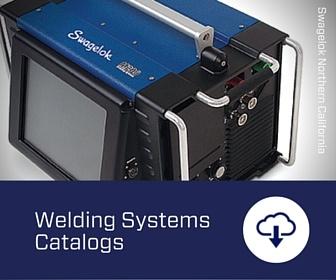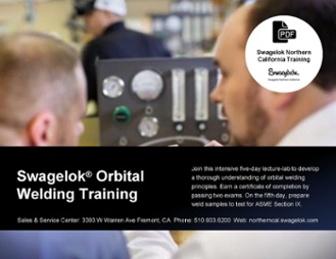Share this
Do You Have The Right Stuff For Good Orbital Welding?
by Jeff Hopkins on 10/3/18 8:45 AM
The chemistry of sulfur, manganese and carbon chemistry all come into play
In general, orbital welding gives better results than manual welding when joining two pieces of tubing without using a fitting. With orbital welding (also known as Gas Tungsten Arc Welding, or GTAW) the welding electrode moves in a circle around the joint, guided by a machine rather than by hand.
For a good weld, though, you also need materials with the right chemical makeup. One of the chief factors in stainless steel, for instance, is the sulfur content. The level of sulfur can make the surface tension of the weld puddle change, affecting the heat flow into the puddle. This characteristic is sometimes called the Marangoni Effect.
Standard 316L stainless usually has sulfur levels in the range of 0.015 percent to 0.025 percent by weight, making it a good choice. As the sulfur content decreases, so does the weldability. That's because the lower sulfur content requires more heat input for a set depth of penetration.
When the sulfur level drops below 0.005 percent by weight, it changes the surface tension of the weld and allows the heat to flow away from the center of the weld puddle.
OK, so what does that mean?
When the heat flows away, weld penetration decreases and the OD width of the weld bead increases. In some cases, the weld can be 50 percent wider when the sulfur content is low. To compensate, the weld heat must be increased, sometimes as much as 40 percent. But that introduces other problems, like reducing the corrosion resistance of the weld and causing more grain growth in the heated zone.
Swagelok Welding Systems (Overview and Literature)
Carbon and Manganese
Too much carbon content can cause problems too. Carbide precipitation can occur at carbon levels above 0.03 percent by weight in stainless, reducing corrosion resistance. There's a tradeoff involved here. The L grade meets carbon content requirements in 304 and 316 stainless steels, but at a cost of an approximately 15 percent loss of strength.
Manganese is released as a vapor during welding and is redeposited downstream of the weld. This is a matter of controversy but is a consideration in only the most corrosive of systems. The cost of material and availability is a major factor. Most surface deposited manganese can be removed by a hot (180°F) DI water rinse for approximately one hour.
Protective ID barrier
Passivation removes the iron particles from the surface of stainless steel and forms a thin chromium oxide film, an inexpensive and effective corrosion resistant barrier in many applications. Passivation can be done before or after installation.
Electropolishing provides for very good surface finishes with a much thicker chromium oxide barrier. Electropolishing is common in UHP systems where clean up time and ultra low contamination are primary concerns. In many cases, it is also a more effective corrosion resistant barrier, but it comes at a large cost.
Swagelok Orbital Welding Training (Next Class: October 22-26, 2018)
Making choices
There are a number of types and classes of materials available for orbital welding, and there is just as large a group of subclasses. You may find yourself ordering 316L, VIM/VAR, ultra low manganese, electropolished to a 5Ra max., hydrogen bright annealed OD with electrically etched mill markings when all you thought you needed was ordinary stainless steel.
The following considerations are some of the most important for selecting a material:
- The material must meet your specific requirements.
- The material can be autogenously welded, which means that no filler is used.
- The material has the best ID surface for your requirements.
- Other components such as fittings, valves, and regulators are readily available in the same material.
- The material is readily available and is cost efficient.
The material of choice, by far, in most systems is 304L stainless steel or 316L stainless steel. Other choices include carbon steels, ferrous alloys, other stainless steels, nickel alloys, refractory and reactive metals. Whenever possible use tubing, not pipe, for your critical systems. Typically, tubing is readily available with the requirements necessary for orbital welding in these systems.
You don't need a degree in metallurgy to navigate all the choices for orbital welding. Just call Swagelok Northern California at 510-933-6200 or contact us through our website. We'll help you find the right mix of materials for your job.
More like this:
- With Proper Training, Orbital Welding Leads the Way (blog article)
- Six Things To Look For In An Orbital Welding Training Course (blog article)
- Designing For Weld Perfection (blog article)
Share this
- Archive (465)
- Assembly Services (207)
- About (100)
- Seal Support Systems (96)
- Best Practices (88)
- Training Services (74)
- Fittings (51)
- Semiconductor Applications (49)
- Hoses and Flexible Tubing (47)
- Regulators (44)
- Tubing (42)
- Grab Sampling Systems (32)
- Sampling Systems (32)
- Gas Systems (30)
- Services (30)
- Downloads (29)
- Valves (24)
- Application Support (18)
- Orbital Welding (17)
- Case Studies (13)
- Steam Systems (13)
- Frequently Asked Questions (12)
- Tools (12)
- Measurement Devices (7)
- Subsystems (6)
- Thermal Management (6)
- September 2023 (1)
- August 2023 (2)
- June 2023 (1)
- March 2023 (3)
- February 2023 (3)
- January 2023 (4)
- December 2022 (4)
- November 2022 (4)
- October 2022 (4)
- September 2022 (1)
- August 2022 (3)
- July 2022 (2)
- June 2022 (4)
- May 2022 (1)
- April 2022 (2)
- March 2022 (1)
- February 2022 (2)
- January 2022 (3)
- December 2021 (1)
- November 2021 (6)
- October 2021 (6)
- September 2021 (8)
- August 2021 (4)
- July 2021 (3)
- June 2021 (6)
- May 2021 (6)
- April 2021 (7)
- March 2021 (5)
- February 2021 (4)
- January 2021 (6)
- December 2020 (5)
- November 2020 (6)
- October 2020 (6)
- September 2020 (8)
- August 2020 (7)
- July 2020 (8)
- June 2020 (8)
- May 2020 (6)
- April 2020 (9)
- March 2020 (7)
- February 2020 (10)
- January 2020 (21)
- December 2019 (23)
- November 2019 (21)
- October 2019 (22)
- September 2019 (21)
- August 2019 (22)
- July 2019 (23)
- June 2019 (20)
- May 2019 (23)
- April 2019 (22)
- March 2019 (21)
- February 2019 (20)
- January 2019 (21)
- December 2018 (14)
- November 2018 (19)
- October 2018 (23)
- September 2018 (17)
- August 2018 (29)
- July 2018 (11)
- June 2018 (6)
- May 2018 (5)
- April 2018 (4)
- March 2018 (5)
- February 2018 (3)
- January 2018 (3)
- December 2017 (2)
- November 2017 (4)
- October 2017 (3)
- September 2017 (2)
- August 2017 (6)
- July 2017 (4)
- June 2017 (4)
- May 2017 (4)
- April 2017 (3)
- March 2017 (4)
- February 2017 (3)
- January 2017 (3)
- December 2016 (3)
- November 2016 (3)
- October 2016 (3)
- September 2016 (5)
- August 2016 (5)
- July 2016 (4)
- June 2016 (5)
- May 2016 (3)
- April 2016 (4)
- March 2016 (5)
- February 2016 (11)
- January 2016 (1)
- December 2015 (3)
- November 2015 (4)
- October 2015 (3)
- September 2015 (4)
- August 2015 (4)
- July 2015 (8)
- June 2015 (5)
- May 2015 (3)
- April 2015 (4)
- March 2015 (4)
- February 2015 (3)
- January 2015 (4)
- December 2014 (2)
- November 2014 (3)
- October 2014 (4)
- September 2014 (4)
- August 2014 (4)
- July 2014 (5)
- June 2014 (4)
- May 2014 (4)
- April 2014 (5)
- March 2014 (4)
- February 2014 (3)
- January 2014 (4)
- December 2013 (5)
- November 2013 (3)
- October 2013 (4)
- September 2013 (3)
- August 2013 (5)
- July 2013 (5)
- June 2013 (5)
- May 2013 (3)
- April 2013 (6)
- March 2013 (4)
- February 2013 (4)
- January 2013 (8)
- December 2012 (4)
- November 2012 (6)
- October 2012 (6)
- September 2012 (4)
- August 2012 (4)
- July 2012 (4)
- June 2012 (4)

.webp?width=210&height=70&name=StickyLogo%20(5).webp)



